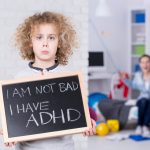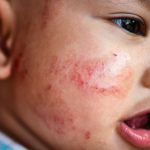The case of Scott: Addressing the Underlying Causes of ADHD
Scott was seven years old when his teachers began recommending that he be evaluated for a possible learning disorder. By age eight he was diagnosed at the local children’s hospital with attention deficit hyperactivity disorder (ADHD). ADHD is generally considered part of the autistic spectrum disorder (ASD). Scott’s teachers complained that he often failed to pay attention to details, did not seem to listen when spoken to directly, often failed to finish tasks, had difficulty organizing tasks and activities, was reluctant to engage in tasks that require sustained mental effort, was forgetful, and tended to fidget and squirm excessively. Recently Scott had started blurting out answers in class before questions had finished. His parents noticed only that he was very finicky about what he ate, liked to eat the same thing every day, and had a real issue with food texture. He would not eat anything mushy. He presented with hyperactivity (but was otherwise well behaved), dry skin and eczema (signs of essential fat deficiency), and dark circles under the eyes (a sign of allergy).
His parents were very concerned about their son and had been doing ADHD research on the Internet. They were offered Ritalin by the pediatrician but wanted to try some other treatments first. They asked the questions most parents do including questions about what went wrong, vaccinations, prevention, and diet. I told them they most likely did nothing wrong and no clear single causative factor has been found for ADHD.
Genetics play a role in the cause of ADHD. Over 20 published studies have suggested associations between ADHD and specific forms of the DAT1 and DRD4 genes. Both these genes are involved in the transport of the brain chemical dopamine. If these genes are not fully active, there is no DAT to “mop up” dopamine from the synaptic cleft in the brain; thus the brains of these people may be flooded with dopamine. The excess dopamine causes restlessness and hyperactivity, behaviors that are exhibited by children with ADHD. Genetic factors and environmental factors work together to cause most diseases. Having mutations in these aforementioned genes may predispose an individual to ADHD.
Nongenetic factors that have been implicated in causing ADHD include poor prenatal care (rare) and exposure to environmental toxins such as lead, mercury, alcohol, or tobacco. While studies of the possible impact of toxins are intriguing, most researchers do not believe this to be a significant causative factor. Possible causes also include food additives, sugar, food allergens, or sensitivities. The effects of these agents have generally remained controversial and have not been proven through rigorous studies. Many studies have related protein deficiency or low calorie intake with behavior or cognitive problems. A deficiency of specific micronutrients (e.g., iron, iodine, and vitamin A) has also been related to behavioral changes.
Stimulant drugs and antidepressants are often used to calm children with ADHD, with a response rate of approximately 75%. It is thought that they increase serotonin levels, which in turn balance the excess dopamine. The advantages of using these medications are that they are quick, low cost, easy, and relatively safe. Disadvantages include common side effects, such as decreased appetite and growth, insomnia, increased irritability, depression or sadness, headache, stomachache, and rebound hyperactivity when the drug wears off. However, these medications do not address the underlying causes of ADHD (Burgess, 2000).
My approach includes identifying and then eliminating environmental, infectious, or dietary causes, ruling out other causes of “acting out,” and helping the parents cope.
Workup
Physical exam
- Hearing tests: normal
- General appearance: dermatitis typical of eczema, allergic shiners, unkempt hair
- No other positive findings
Lab tests with results
- Essential and toxic mineral hair analysis: elevated mercury and aluminum, calcium and magnesium were low.
- Stool testing to rule out Candida, unbalanced bacteria (dysbiosis), and poor digestive function. No acidophilus, low bifidobacteria, some overgrowth of possible pathogens, no significant overgrowth of Candida spp.
- Essential fatty acids (DHA, EPA omega-6 omega-3 ratio, etc.): low in omega-3
- Food antibody testing (IgG,IgE): Positive for soy++, cheese+++, yeast+, raspberries+, apples++, corn gluten++, almonds+, wheat++, and some shellfish++.[1]
- Neurotransmitter testing (serotonin, dopamine, norepinephrine, epinephrine, GABA): serotonin was very low, dopamine was “low normal.”
Treatment
- Magnesium citrate 200 mg: Magnesium deficiency in children with ADHD occurs more frequently than in healthy children. In one study, magnesium deficiency was found in 95% of children with ADHD (Kozielec and Starobrat-Hermelin, 1997).
- Orange-flavored cod liver oil 1 teaspoon (545 mg DHA, 363 mg EPA): Purdue University researchers found in a June 1996 study that boys with low blood levels of essential omega-3 fatty acids have a greater tendency toward problems with behavior, learning, and health consistent with ADHD. In response to this breakthrough, a second Purdue study is being conducted. Scott’s essential fatty acid test revealed an imbalance between omega-6 and omega-3 fats in his red blood cells.
- Avoidance of gluten and dairy: The theory behind this is that many if not all autistic spectrum children have a damaged intestinal lining leading to intestinal permeability or “leaky gut.” This leaky gut allows food particles to pass through into the bloodstream only partially digested. This is of particular concern for the gluten from wheat/oats/rye/barley, and the casein from milk and other dairy products. Casomorphine, gliadomorphin, dermorphin, and deltorphin II are the compounds in question found in gluten and dairy products. These opioid-like mild altering byproducts of wheat and dairy consumption and are often found elevated in ASD patients. Dermorphin and deltorphin interfere with memory, attention, behavior (causing hyperactivity as well as stereotypic activity), and temperature control (lowering basal body temperature), and cause abnormal waves. These compounds are more than 1 million times more potent than morphine. However, they bind to a different kind of receptor than morphine or human endogenous opioids like the endorphins.
- The Feingold diet: The Feingold diet eliminates salicylates, synthetic additives, dyes, and chemicals, which are commonly added to processed foods. The yellow dye tartrazine has been specifically shown to provoke symptoms in controlled studies of ADHD-affected children (Rowe and Rowe, 1994). As many as 10% to 25% of ADHD children may be sensitive to salicylates (Williams and Cram, 1978).
- Food allergy testing: Testing revealed elevated antibodies to a number of foods. These foods were eliminated for a minimum of 6 months. I told Scott and his parents that at the end of that period we would slowly reintroduce some of the foods and record any behavioral changes.
- Reducing toxic load: To lower the “total load” on the body from other possible toxins we also had Scott eliminate preservatives, seafood other than wild salmon (because of mercury), food colorings, artificial sweeteners, MSG, and artificial flavorings. We asked that he drink only filtered water, and prepare and store food in inert containers only (not plastics).
- Zinc 60 mg: Part of a multistep strategy to promote metallothionein (MT) synthesis in the GI tract, brain, and elsewhere. Dr. William Walsh and Dr. Anjum Usman (Walsh et al., 2001) have discovered defective functioning of metallothionein protein (MT) in ASD. This abnormality results in impaired brain development and sensitivity to toxic metals and other environmental factors. In humans, MT proteins regulate blood levels of trace minerals, detoxify mercury and other heavy metals, and assist in neuronal development (Walsh et al., 2002). Defective functioning of MT proteins may be the underlying cause of autism. Zinc dosages vary with body weight. A rule of thumb is to provide a daily mg dosage of Zn equal to weight (lbs) plus 15-20 mg. Increasing MT is expected to provide many benefits to autism spectrum patients, including elimination of toxic metals, protection against future toxic exposures, normalization of the GI tract, improved behavior control, improved immune function, and enhanced development of brain neurons and synaptic connections.
- Toxic metal removal with DMSA (Meso-2,3-dimercaptosuccinic acid is a water-soluble, nontoxic, metal chelator that has been in use as an antidote to heavy metal toxicity since the 1950s) 100 mg three times a day 3 days on, 11 days off: Scott’s hair analysis demonstrated elevated mercury and aluminum, indicating exposure within 90 days. It came as no surprise that Scott liked tunafish sandwiches and had been fully immunized with non-thimerosal free vaccines. According to numerous experts, autism, autistic spectrum disorders, and ADD have similar characteristics to those of chronic metal toxicity. Neuroses, including schizoid and obsessive-compulsive traits, problems in inhibition of perseveration, and stereotyped behaviors have been reported in the medical literature (Fagala and Wigg, 1992; O’Carroll et al., 1995; Clarkson, 1997; Camerino et al., 1981). Clinically, I see a 50% improvement when mercury is removed from these kids.
- Neurotransmitter therapy: Designed to raise serotonin levels.
- Hypoallergenic children’s multivitamin: 2 per day.
- Probiotics (Bifidobacterium bifidum, Lactobacillus acidophilus, Lactobacillus casei, Saccharomyces boulardii, etc.) 1/4 teaspoon per day with food: Probiotic bacteria inhibit the growth of harmful bacteria and yeasts, promote good digestion, boost immune function, and increase resistance to infection. I was not surprised to see that Scott had very low levels of these beneficial bacteria. His yeast growth was within normal limits and did not appear to be a pathologic factor.
Results
As usual, his teachers were the first to notice changes. They noted on report cards that Scott’s behavior had improved dramatically and that he was no longer a discipline problem. His grades improved slightly. He continues to be fussy about food but now will eat a wider variety of foods. He did not like eliminating cheese and wheat and this is proving to be a challenge. I plan to run a special test that will detect dermorphin and deltorphin II in the urine. If after reintroducing gluten and dairy products he is negative for these compounds, we will allow these foods back in the diet and monitor for behavioral changes. I saw Scott at 8-week follow-ups over the next 9 months and continue to see him every 3 months now. Most of the improvement occurred in the first 6 months. His grades have continued to improve. The parents are very pleased. Scott just wants to eat pizza again.
References
Burgess JR et al: Long-chain polyunsaturated fatty acids in children with attention-deficit hyperactivity disorder, Am J Clin Nutr 71(1 Suppl):327S-30S, 2000. Review.
Camerino D et al: Behavior of some psychological parameters of a population of a Hg extraction plant, Clin Toxicol 18(11):1299-1309, 1981.
Clarkson T: The toxicology of mercury, Crit Rev Clin Lab Sci 34(3):369-403, 1997.
Fagala GE, Wigg CL: Psychiatric manifestations of mercury poisoning, J Am Acad Child Adolesc Psychiatry 31(2):306-11, 1992.
Kozielec T, Starobrat-Hermelin B: Assessment of magnesium levels in children with attention deficit hyperactivity disorder (ADHD), Magnes Res 10(2):143-8, 1997.
O’Carroll RE et al: The neuropsychiatric sequelae of mercury poisoning: the Mad Hatters disease revisited, Br J Psychiatry 167(1):95-8, 1995.
Rowe KS, Rowe KJ: Synthetic food coloring and behavior: a dose response effect in a double-blind, placebo-controlled, repeated-measures study, J Pediatr 125:691-8, 1994.
Walsh WJ et al: Disordered Metal Metabolism in a Large Autism Population, Proceedings of the Amer. Psych. Assn.; New Research: Abstract NR109, New Orleans, May 2001.
Walsh WJ et al: Metallothionein and Autism, ed 2, Naperville, IL, 2002, Pfeiffer Treatment Center.
Williams JI, Cram DM: Diet in the management of hyperkinesis: a review of the tests of Feingold’s hypotheses, Can Psychiatr Assoc J 23:241-8, 1978. Review.
[1] Three +++ indicates the highest number of antibodies found.
 Stephen W. Parcell, ND, is a licensed naturopathic physician and graduate of Bastyr University, with additional training at the American Academy for the Advancement of Medicine and the American Academy of Environmental Medicine. Dr. Parcell is certified in chelation therapy and, after completing the Autism Research Institute’s physician training program, a certified Defeat Autism Now (DAN) practitioner. He is past vice president of the Colorado Association of Naturopathic Physicians. Dr. Parcell currently works at NatureMed, LLC, a naturopathic medical clinic in Boulder.
Stephen W. Parcell, ND, is a licensed naturopathic physician and graduate of Bastyr University, with additional training at the American Academy for the Advancement of Medicine and the American Academy of Environmental Medicine. Dr. Parcell is certified in chelation therapy and, after completing the Autism Research Institute’s physician training program, a certified Defeat Autism Now (DAN) practitioner. He is past vice president of the Colorado Association of Naturopathic Physicians. Dr. Parcell currently works at NatureMed, LLC, a naturopathic medical clinic in Boulder.










